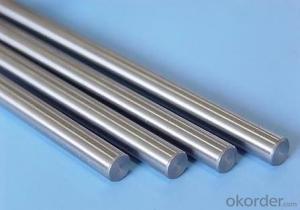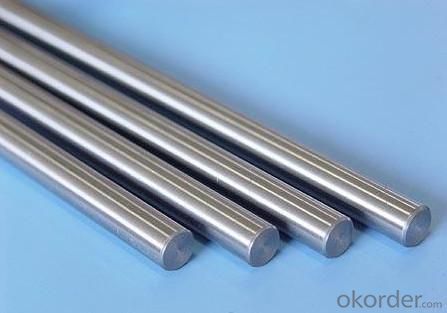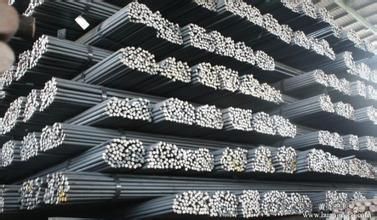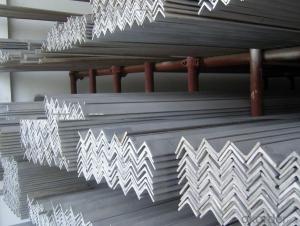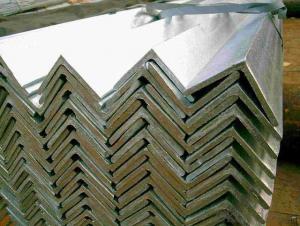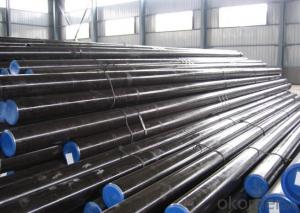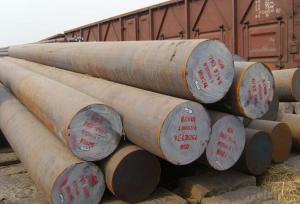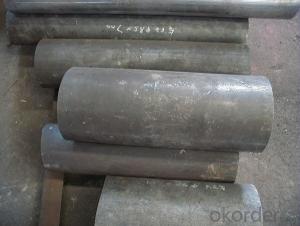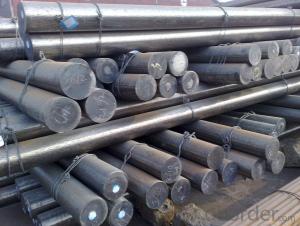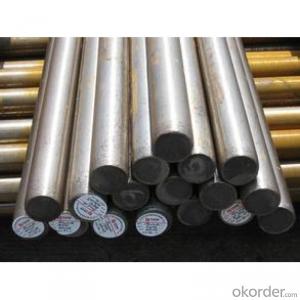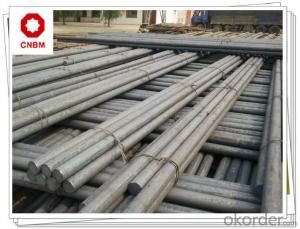SAE1020 Special Bar Type
- Loading Port:
- China Main Port
- Payment Terms:
- TT or LC
- Min Order Qty:
- -
- Supply Capability:
- -
OKorder Service Pledge
OKorder Financial Service
You Might Also Like
Product Description:
OKorder is offering SAE1020 Special Bar Type at great prices with worldwide shipping. Our supplier is a world-class manufacturer of steel, with our products utilized the world over. OKorder annually supplies products to European, North American and Asian markets. We provide quotations within 24 hours of receiving an inquiry and guarantee competitive prices.
Product Applications:
SAE1020 Special Bar Type are ideal for structural applications and are widely used in the construction of buildings and bridges, and the manufacturing, petrochemical, and transportation industries.
Product Advantages:
OKorder's SAE1020 Special Bar Type are durable, strong, and resist corrosion.
Main Product Features:
· Premium quality
· Prompt delivery & seaworthy packing (30 days after receiving deposit)
· Corrosion resistance
· Can be recycled and reused
· Mill test certification
· Professional Service
· Competitive pricing
Product Specifications:
Manufacture: Hot rolled
Grade: Q195 – 235
Certificates: ISO, SGS, BV, CIQ
Length: 6m – 12m, as per customer request
Packaging: Export packing, nude packing, bundled
Chinese Standard (H*W*T) | Weight (Kg/m) | 6m (pcs/ton) | Light I (H*W*T) | Weight (Kg/m) | 6m (pcs/ton) | Light II (H*W*T) | Weight (Kg/m) | 6M |
100*68*4.5 | 11.261 | 14.8 | 100*66*4.3 | 10.13 | 16.4 | 100*64*4 | 8.45 | 19.7 |
120*74*5.0 | 13.987 | 11.9 | 120*72*4.8 | 12.59 | 13.2 | 120*70*4.5 | 10.49 | 15.8 |
140*80*5.5 | 16.89 | 9.8 | 140*78*5.3 | 15.2 | 10.9 | 140*76*5 | 12.67 | 13.1 |
160*88*6 | 20.513 | 8.1 | 160*86*5.8 | 18.46 | 9 | 160*84*5.5 | 15.38 | 10.8 |
180*94*6.5 | 24.143 | 6.9 | 180*92*6.3 | 21.73 | 7.6 | 180*90*6 | 18.11 | 9.2 |
200*100*7 | 27.929 | 5.9 | 200*98*6.8 | 25.14 | 6.6 | 200*96*6.5 | 20.95 | 7.9 |
220*110*7.5 | 33.07 | 5 | 220*108*7.3 | 29.76 | 5.6 | 220*106*7 | 24.8 | 6.7 |
250*116*8 | 38.105 | 4.3 | 250*114*7.8 | 34.29 | 4.8 | 250*112*7.5 | 28.58 | 5.8 |
280*122*8.5 | 43.492 | 3.8 | 280*120*8.2 | 39.14 | 4.2 | 280*120*8 | 36.97 | 4.5 |
300*126*9 | 48.084 | 3.4 | 300*124*9.2 | 43.28 | 3.8 | 300*124*8.5 | 40.87 | 4 |
320*130*9.5 | 52.717 | 3.1 | 320*127*9.2 | 48.5 | 3.4 | |||
360*136*10 | 60.037 | 2.7 | 360*132*9.5 | 55.23 | 3 |
FAQ:
Q1: Why buy Materials & Equipment from OKorder.com?
A1: All products offered byOKorder.com are carefully selected from China's most reliable manufacturing enterprises. Through its ISO certifications, OKorder.com adheres to the highest standards and a commitment to supply chain safety and customer satisfaction.
Q2: How do we guarantee the quality of our products?
A2: We have established an advanced quality management system which conducts strict quality tests at every step, from raw materials to the final product. At the same time, we provide extensive follow-up service assurances as required.
Q3: How soon can we receive the product after purchase?
A3: Within three days of placing an order, we will begin production. The specific shipping date is dependent upon international and government factors, but is typically 7 to 10 workdays.
Q4: What makes stainless steel stainless?
A4: Stainless steel must contain at least 10.5 % chromium. It is this element that reacts with the oxygen in the air to form a complex chrome-oxide surface layer that is invisible but strong enough to prevent further oxygen from "staining" (rusting) the surface. Higher levels of chromium and the addition of other alloying elements such as nickel and molybdenum enhance this surface layer and improve the corrosion resistance of the stainless material.
Q5: Can stainless steel rust?
A5: Stainless does not "rust" as you think of regular steel rusting with a red oxide on the surface that flakes off. If you see red rust it is probably due to some iron particles that have contaminated the surface of the stainless steel and it is these iron particles that are rusting. Look at the source of the rusting and see if you can remove it from the surface.
Images:
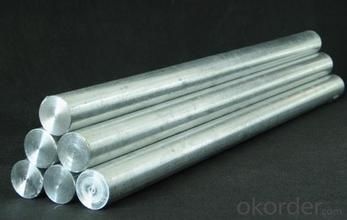
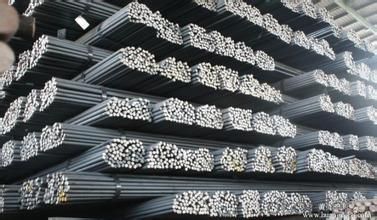
- Q: What are the guidelines for designing connections using steel angles?
- The guidelines for designing connections using steel angles typically involve determining the appropriate angle size, thickness, and length based on the loads and forces that will be applied to the connection. Additionally, considerations such as the type of welds or bolts to be used, the spacing and arrangement of the angles, and any applicable design codes or standards must be taken into account. It is important to ensure that the connection is structurally sound and provides adequate strength and stability for the intended application.
- Q: How do you prevent steel angles from warping?
- To prevent the warping of steel angles, there are several measures that can be taken: 1. Store the steel angles in a dry environment and avoid moisture exposure. This will prevent rust and warping. Use pallets or racks to store them horizontally, minimizing bending stress. 2. Employ controlled cooling techniques during fabrication. Rapid temperature changes can induce warping, so it is important to cool gradually. Air cooling or controlled cooling baths can help avoid thermal stresses and minimize warping. 3. Minimize heat input during welding. Excessive heat can cause localized thermal expansion and contraction, leading to warping. Utilize proper welding techniques such as shorter welding times, smaller weld beads, and intermittent welding to control the temperature gradient and minimize heat input. 4. Consider preheating and post-welding stress relief for thicker or high-strength steel angles. Preheating before welding can reduce the risk of warping, and post-welding stress relief heat treatments can relieve any residual stresses and prevent warping. 5. Handle and transport the steel angles properly. Adequately support and secure them during transit to avoid bending or flexing. Avoid dropping or mishandling, as this can introduce structural deformations that lead to warping. By implementing these preventive measures, the risk of steel angles warping can be minimized, ensuring their structural integrity for various applications.
- Q: What are the different tolerances for steel angles?
- The different tolerances for steel angles depend on the specific manufacturing standards and specifications. Generally, the tolerances for steel angles are determined by the governing bodies or organizations that set industry standards, such as the American Society for Testing and Materials (ASTM) or the International Organization for Standardization (ISO). The tolerances for steel angles can vary based on factors such as the angle's dimensions, shape, and intended application. These tolerances ensure that the angles meet the required dimensional and geometric specifications, allowing them to be used effectively in various structural or engineering applications. Some common tolerances for steel angles include: 1. Dimensional Tolerances: These tolerances define the allowable variations in length, width, and thickness of the angle. For example, a 90-degree angle might have a tolerance of +/- 1/8 inch in its leg length or a maximum deviation of 2 degrees from the specified angle. 2. Straightness Tolerances: This tolerance measures the allowable deviation from a straight line along the length of the angle. It ensures that the angle does not have excessive bends or twists, which may affect its structural integrity. 3. Surface Finish Tolerances: These tolerances specify the acceptable variations in the surface finish of the angle, such as roughness or surface irregularities. They ensure that the angle meets the required aesthetic and functional standards. 4. Squareness Tolerances: Squareness tolerance measures the maximum allowable deviation from a perfect right angle for angles that are specified to be 90 degrees. It ensures that the angle maintains its intended shape and can be properly joined or connected to other components. 5. Weight Tolerances: These tolerances define the acceptable variations in the weight of the steel angle. They ensure that the angle meets the specified weight requirements, which may be crucial in applications where weight distribution plays a role. It is important to note that the specific tolerances for steel angles may vary depending on the region, industry, or project requirements. Therefore, it is essential to consult the relevant standards or specifications to determine the appropriate tolerances for a specific steel angle.
- Q: Can steel angles be painted or coated after installation?
- Yes, steel angles can be painted or coated after installation. Painting or coating steel angles provides an added layer of protection against corrosion, enhances their aesthetic appeal, and can help them blend in with their surroundings.
- Q: What is the use of angle steel and channel steel?
- Used to make steel structures, such as steel staircases, plant supports, etc..
- Q: Can steel angles be used for staircases or handrails?
- Yes, steel angles can be used for staircases or handrails. Steel angles provide structural support and can be used to create sturdy and durable staircases and handrails. They are commonly used in construction for their strength and versatility.
- Q: How do steel angles perform in corrosive gas or liquid environments?
- The strength and versatility of steel angles make them a popular choice for various structural applications. However, their performance in corrosive gas or liquid environments can be impacted by the grade of steel used and the concentration and nature of the corrosive substance. When exposed to corrosive gases or liquids, steel angles can undergo corrosion, leading to a gradual deterioration of their structural integrity. The extent of corrosion depends on factors such as exposure time, temperature, humidity, and the corrosiveness of the gas or liquid. To counteract the effects of corrosion, protective coatings can be applied to steel angles used in corrosive environments. Examples of common protective coatings include galvanization, which involves adding a layer of zinc to the steel surface, as well as epoxy or polyurethane coatings. These coatings create a barrier that prevents direct contact between the corrosive substance and the steel, thereby slowing down the corrosion process. However, it is important to acknowledge that even with protective coatings, steel angles may still experience some level of corrosion over time. The extent of corrosion will depend on the quality and durability of the coating, as well as the regular maintenance and inspection of the steel angles. In extremely aggressive or highly concentrated corrosive environments, steel angles may not be the most suitable choice. In such cases, alternative materials like stainless steel or corrosion-resistant alloys may be more appropriate. In conclusion, the performance of steel angles in corrosive gas or liquid environments is influenced by specific conditions and protective measures in place. Regular inspection, proper maintenance, and the use of suitable coatings are vital for ensuring the longevity and performance of steel angles in corrosive environments.
- Q: How do steel angles contribute to the overall strength of a structure?
- The overall strength of a structure is enhanced by steel angles in various ways. Firstly, they contribute to structural stability by evenly distributing the load and forces across the entire structure. The unique L-shape of steel angles enables them to resist bending and twisting, making them highly suitable for providing support and preventing deformation. Due to their high strength-to-weight ratio, steel angles are frequently utilized as bracing elements in construction. Incorporating diagonal steel angles into a structure enhances its resistance to lateral forces like wind or seismic loads. These angles effectively transfer the applied forces to the foundation, reducing the risk of structural failure. Additionally, steel angles reinforce a structure by being strategically placed at critical points, such as corners or joints. This strategic placement enhances the overall rigidity and durability of the structure. Steel angles can also serve as framing members, supporting beams, or columns, further strengthening the structure's load-bearing capacity. Furthermore, steel angles possess resistance to corrosion and have a long lifespan, making them a reliable choice for structural applications. They can endure harsh environmental conditions, ensuring the building's structural integrity over an extended period. In conclusion, steel angles play a vital role in augmenting the strength and stability of a structure. Their ability to distribute loads, resist bending and twisting, provide reinforcement, and withstand environmental factors make them an indispensable component in modern construction.
- Q: What is the tensile strength of steel angles?
- The tensile strength of steel angles can vary depending on the specific grade of steel and the manufacturing process used. However, generally speaking, steel angles have a high tensile strength. Common grades of steel used for angles, such as A36, have a tensile strength of around 58,000-80,000 psi (pound-force per square inch). However, higher strength steel grades, such as A572 or A588, can have tensile strengths exceeding 100,000 psi. It is important to consult the specific grade and manufacturer's specifications to determine the exact tensile strength of steel angles in a given application.
- Q: What are the different types of steel angles used in automotive engineering?
- In automotive engineering, there are several types of steel angles that are commonly used. These angles play a crucial role in providing structural strength, improving stability, and enhancing the overall performance and safety of vehicles. Here are some of the different types of steel angles used in automotive engineering: 1. L-angles: L-angles, also known as unequal angles, are often used in automotive engineering to provide structural support and reinforcement. These angles have different lengths on each side, allowing them to be easily welded or bolted onto various components of a vehicle's chassis or frame. 2. T-angles: T-angles, also known as tee angles, are frequently used in automotive engineering to join two components together at a right angle. These angles are designed with a flat base and a vertical stem, which enables them to provide stability and hold different parts of a vehicle securely in place. 3. C-angles: C-angles, also known as channel angles, are commonly utilized in automotive engineering to form the framework for various vehicle structures. These angles have a U-shaped cross-section and are often used to create structural components like door frames, roof rails, and chassis reinforcements. 4. Z-angles: Z-angles, also known as Z-bar angles, are widely employed in automotive engineering to provide strength and rigidity to different vehicle structures. These angles have a Z-shaped cross-section, which allows them to resist bending and torsional forces effectively. Z-angles are often used in applications such as suspension systems, roll bars, and body components. 5. U-angles: U-angles, also known as U-bar angles, are commonly used in automotive engineering to provide support and reinforcement to various vehicle components. These angles have a U-shaped cross-section and are frequently utilized to create structural members like bumper beams, frame reinforcements, and roll cage bars. These are just a few examples of the different types of steel angles used in automotive engineering. Each angle has its own unique properties and applications, and their selection depends on the specific requirements of the vehicle design and the desired structural integrity.
Send your message to us
SAE1020 Special Bar Type
- Loading Port:
- China Main Port
- Payment Terms:
- TT or LC
- Min Order Qty:
- -
- Supply Capability:
- -
OKorder Service Pledge
OKorder Financial Service
Similar products
Hot products
Hot Searches
Related keywords
